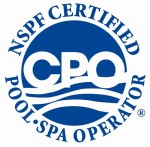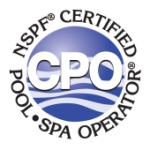| The two most important reasons to test the water.#1 To Protect the User
The goal of every pool and spa owner is to have sparkling, clean water. Unfortunately, a variety of undesirable substances will often enter a pool or spa. Such items can make the water unhealthy. There are bacteria on every person’s body that can get into water; some forms can cause infections or rashes. User perspiration and urine break down to undesirable nitrogen compounds and “Mother Nature” can also contribute: rain, algae spores, leaves and other organic materials. All of these necessitate the use of a sanitizer, such as chlorine. The total ideal range of free chlorine in swimming pools is 1-3 ppm. Spa owners should keep in mind that the ideal free chlorine range in spas (hot tubs) is between 2 and 4 ppm. #2 To Protect the Pool or Spa Everything that the water contacts is affected by the chemistry of the water itself. The surfaces of the pool or spa, the heater, the filter, the steps, and the pump can be damaged if the water is either corrosive or scale forming. The goal of the water analyst is to keep the water “in balance” so it does not damage the pool and its equipment. By maintaining each test factor of pH, alkalinity, and hardness within the “Ideal Range” the water will not harm the pool or spa surfaces and components. Additional Reasons to Routinely Test Your Water. In addition to the obvious goal of determining what treatment chemicals are needed to protect the user and the pool or spa there are many other good reasons to test the water.
How much treatment chemical to add – By testing the water and using the treatment amount on the chemical product label, the analyst can closely predict how much treatment chemicals are needed. This testing avoids a costly overdose of chemicals that can create larger problems than the original one.
Total Alkalinity – To avoid undesirable changes in the pH level the alkalinity must be maintained in the ideal range (near 100 ppm). Total alkalinity helps to stabilize the pH of the water so that chemical treatments or environmental conditions will not rapidly raise or lower the pH to a damaging level. Such changes can also occur after adding large doses of chlorine, since one form of chlorine may have a very low pH while another a very high pH. If the pH of your source water is high or low, consult with a pool professional to select a type of chlorine or sanitizer that makes sense for your water and the environmental conditions.
Total Chlorine – If the total chlorine level ever exceeds the free chlorine level, a superchlorination or shock treatment is needed. High total chlorine levels indicate that undesirable ammonia or nitrogen compounds have “combined” with the free chlorine to make the sanitizer much less active and create odor and swimmer irritation.
Total Hardness – When a hardness level is too low, it can cause corrosion. If it is too high, it can settle or “drop out” of solution as chalky white or tan colored deposits on component surfaces. These deposits, often referred to as “scale,” could eventually lead to clogged pipes, or damaged motors, heaters, and filters. |




